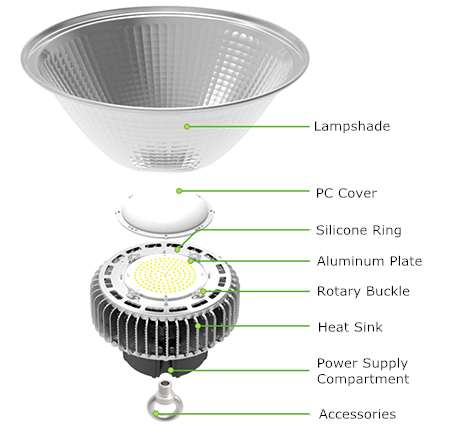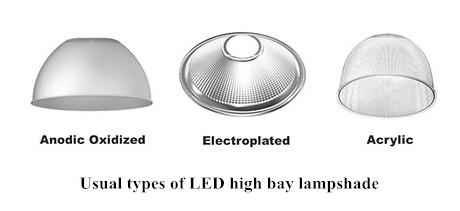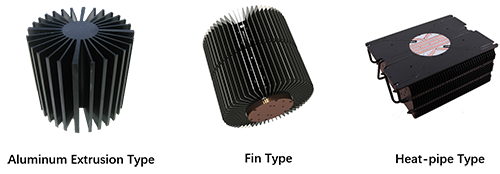Factories and Manufacturers of LED High Bay Lighting in China is fastly increasing in recent years due to wide use and needs of LED High Bay Lighting from global countries. LED High Bay Lighting made in China have many options on the market and it is critical to buy LED High Bay Lighting products with reliability and stable performance. After the period of product warranty given by the china manufacturer and supplier, how long will be the lifespan of those LED High Bay Lighting fixtures? If you install and use LED High Bay Lighting in commercial & industrial lighting areas, do consider what you will expect to get from LED High Bay Lighting with different quality and prices.
These LED high bay light fixtures use 85% less electricity than a standard lamps. In addition, the lifespan of an LED high bay is 8-10 times longer than the lifespan of standard bulbs and can withstand more shock. Our LED high bay fixtures turn on at 100% of their brightness every single time, lasting up to 50,000 hours. All of our LED light fixtures are specially designed to focus light on a specific location or direction, without relying on an external reflector.
Our experienced sales staff and products specialists are customer-focused, making the transition from traditional lighting to LED an informed and simple process. Our mission is to be a truly reliable manufacturer and true partner in the distribution of top-quality, energy-efficient, value-priced lighting prodcuts.
Great improved visibility and functionality, high bay LED lighting is the best LED light fixture to illuminate large open spaces with mid-to-high ceilings, including manufacturing plants, gyms, warehouses and auditoriums. High bay LED lighting fixtures are designed for applications of 20 feet (6 meters) or more, providing specific light patterns for your high bay lighting applications, including maintenance lighting, warehouse lighting, recreation center lighting, hangar lighting and storage lighting.
And by using LED lights, you’ll enjoy better quality light than with a halogen or fluorescent system while using less energy, improving visibility, productivity and safety at any hour of the day.In the past, high-intensity discharge (HID) lamps were the light source of choice for large, high-ceiling environments such as factories, warehouses, gymnasiums, and big-box retail stores. First replaced by fluorescents, LED high bay lighting is the most energy-efficient option on the market. Designed for warehouse lighting, recreation centers, hangars, and storage facilities, these indoor lighting fixtures improve visibility and worker safety while enhansing productivity.
LED high bay fixtures are instant on and do not lose life hours from constant on-off cycles the way metal halide (HID) fixtures do.When the day comes that you need to replace a light, our LED Ready High Bays make it easy to swap out a bad tube rather than replacing the whole fixture. You’ll also enjoy unmatched manufacturer warranties along with the support of our certified lighting specialists.
Thanks to LED high bay lights, lighting has undergone a huge transformation and now the market is changing once again, in recent years. As a high brightness LED light source, they will light up highway toll stations, gas stations, workshops, stadiums, exhibition halls, plants, large supermarkets, mining areas, and many more. Depending on how high it is needed, there are two different products – LED low bay light and LED high bay light. Commonly, the low bay option will be used for 20 feet and boasts 20-80W whereas the High Bay option is more powerful with over 100W and will therefore project well over 20 feet.
Advantages of LED High Bay Lights
Compared to the bulbs that we have been using for many years – including the halogen, high-intensity, incandescent bulbs, and even fluorescent tubes – the LED high bay lights have many benefits. Firstly, technology in lighting continues to make giant leaps forward which means that brightness is improving for a lower cost. As well as a reduction in costs, they are also becoming more reliable than ever before.
Traditionally, people would avoid the high bay light option because they were somewhat bulky, they consumed a large amount of power, required high maintenance costs and they weren’t the most environmentally-friendly. In early times, LED high bay lights were larger and heavier due to the large aluminum radiator. With the development of the technology in modern times though, LED chips now have better performance in heat resistance without relying on huge radiating device.
Nowadays, a single LED high bay light can reach a whopping 2,000W but they are more commonly found at around 500W. Conventionally, the high bay lights would use common lighting sources including metal halide lamps, mercury lamps, fluorescent lamps, AC voltage, and 50Hz operating frequency which would result in a flicker and would fatigue the human eye. Additionally, they could not be started in a quick time because the filament needed to pre-heat. Due to the mercury and other potentially harmful gases, they were also pollution to the environment.
As mentioned previously, times are changing and the development in recent years has been phenomenal. Not only are they longer-lasting than ever before, they will also save energy and they require less maintenance than other options. For people of all ages, this is now a fantastic option for all sorts of tasks from filling a stadium with light to bringing light to a workshop. On a 250W high bay light, the manufacturers have been able to utilise the same energy efficiency as a 100W light which has rarely been seen before.
In the past, we have seen many shortcomings with the traditional light sources including the surface temperature of up to 300 degrees which has caused burns to users. With an LED high bay light, it has been designed to not reach anything higher than 90 degrees. Thanks to a brilliant thermal design, all surfaces stabilize at around 60 degrees which severely reduces the risk of burns as well as fires. In a location with high security as well as having high levels of health and safety in place, high bay lights are the ideal solution.
As you can see from the points above, high bay lights are becoming stronger and stronger and now present themselves as a more efficient, longer-lasting, low energy consumption bulb. When looking into lights of this type, all of the above is rendered useless if the light itself isn’t good but high bay lights have fantastic colour rendering and provide a number of different options depending on your needs and the needs of the environment. When in place, it provides a comfortable lighting for all below to utilise and become more efficient.
Typical Structure of LED High Bay Light
As a general rule of thumb, LED high bay light structures include radiator, power supply cabin, light-emitting components (LED light board and lens), lampshade, and installation accessories and instructions.

1) LED Light-Emitting Components
In order to be the light it is, high bay lights use high-power SMD or even an integrated LED Array. After the LED light board is fixed to the surface of the radiator, LED light will be found outside with a glass or PC material in order to protect the source itself and distribute the result evenly. In terms of transmittance and corrosion resistance performance, using glass lens material is generally much better than PC lens material, but there is a higher cost involved. After installing the lamp itself, the spacing and height will affect how the LED light travels through the lens at different angles.
2) Lampshade
Typically, LED high bay lights are used with a similar shaped shade which allows for maximum protection and adjustment whenever necessary. Recently, we have seen the growth of UFO high bay lights and these are essentially the same but come without reflectors. With this in mind, they have to be replaced with the light lens in order to distribute light otherwise it will not have the same function in larger rooms. For example, the light would struggle to reach the floor in rooms with higher ceilings if this feature didn’t exist.

Finishing treatments of lampshade
Besides different reflecting angles, there’re different finishing treatments to reach different lighting functions. Anodic Oxidation is a very typical treatment for anticorrosive purpose and it enhances the surface strength of the aluminium sheet so that it will not be scratched easily. This treatment is cost effective and productative therefore is very popular.
To reach a higher reflective rate therefore higher lumen efficiency some manufacturers use electroplating treatment. This treatment process forms a mirror finish by coating a new metal (alloy) layer on the surface of aluminium lampshade. However electroplating is expensive due to high environmental protection cost.
There’s also acrylic lampshade with which partcial of the light will emerge from the lampshade body to illuminate the upper space of the building. By using Acrylic lampshade the whole room will reach a good balance of brightness, people feel less visual fatigue when eyes move verticaslly. Naturally Acrylic lampshade will reduce the center illumination on the ground.
3) Heat Sink
With a large light power available in high bay lights, the choice of radiator becomes a little more prominent and will largely affect the life of the light fixtures. Over time, the chip can become damaged due to high heat when electrified; if the radiating speed isn’t fast, the heat is contained within the chip and can reduce the life of the light. As well as chip damage, this same process will also cause phosphor variation and carbonisation of silica gel.
Therefore, the radiator will be given a large amount of fins to increase the contact with outside air. With this design, the radiator heats around the air of the fin which then rises to form negative pressure around the fins. Then, the cold air comes around the bottom removing the pressure and starting the cycle again. Thanks to this process, lights will last longer and the risk of severe damage will be reduced.
Commonly, the LED heat sink can be found in three different types according to their design principles.

Aluminum Extrusion Type. Firstly, this can be manufactured by making use of the fact that aluminum has a high thermal conductivity.
Fin Type. By continuously punching, this can be coupled with aluminum sheets which will then increase the area of the heat exchange.
Heat Pipe Type. With the heat pipe, it uses a combination of the heat sink and a copper pipe which is pre-filled with internal heat conduction. With this in mind, the speed of heat conduction is increased and the radiator is allowed to become more efficient.
In order to help heat radiation, LED high bay lights need to have a certain surface area and this cannot be achieved with die-casting. Therefore, you will rarely find a die-cast radiator these days as there are simply more efficient ways of going about the same process.
4) LED High Bay Light Power Supply
Generally, an LED high bay light is installed high up above and therefore require professionals to put it in place and install it correctly. When compared with ordinary household lamps, these clearly need more maintenance and the installation costs can be significant. On the whole, the life of an LED high bay light is largely dependant on the quality of the drive power. In truth, many industrial locations that use a grid stability are worse off than residential areas in terms of current instability, voltage fluctuations, frequent surges, and more. With this in mind, the high bay lights look to take advantage of an isolation type of drive so that there is a wide voltage design and surges and voltage fluctuations are more protected.
5) Power Supply Cabin
With many high bay lights holding the power within the radiator, the new designs are looking to save costs and reduce the overall size of the lamp. However, there is a huge drawback in that the heat will be transmitted to the drive power internal components and there is a real risk of the temperature overheating. In lighting such as this, heat and temperature is a key feature and some electrical components, such as electrolytic capacitors, have a direct relationship between heat and life.
With an electrolytic capacitor, the temperature will see a ten degree rise and this can cut its life in half. With this in mind, newer models of high bay lights install the power within a sealed die-cast aluminum power cabin so the heat is kept completely separate. In addition to this, the cabin also holds a small cooling function which dramatically affects the life of one single unit. Although it isn’t as good, there are also some designs that allow air directly into the cabin but this doesn’t provide as much protection.
6) Accessories
When looking to install a light such as this, it needs to be completed carefully because there is a real risk falling or dropping heavy equipment. Of course, most models will have screws with which the high bay lights can be attached to the wall or the ceiling but care still needs to be taken because it requires work at high-altitude. Although most installation steps will be fairly straightforward, the complexity of the task will largely depend on the structure of the building and what options are available. For example, the light shouldn’t be installed where it will be constantly blown by the wind as this will cause damage over time and reduce the life of the lamp. Furthermore, it could weaken the connection and fall.
Protection Degree of LED High Bay Lights
In terms of protection, many different manufacturers claim that they can reach IP65 in the outdoors but each one does need to be identified individually. As we discussed a little earlier, high bay lights very rarely use whole die-casing radiators anymore so newer models should always be sought. With fin-type or aluminum, the benefits far outweigh anything else so this will be the safest and more efficient option. However, it should be noted that the connection gap can actually be quite large and so might require a silicon seal for maximum protection.
Choosing the right LED light can be essential for any business but you should now have the knowledge you need to assess your options, purchase the light, and then choose a location for installation. If you need help at any point, don’t be afraid to ask for help from a professional because this will be the safest method of installation. By choosing a professional, you can ensure that everything gets installed correctly and that it isn’t susceptible to wind damage or anything else. As soon as it is installed correctly, your maintenance costs will be reduced and the maximum possible life can be achieved!